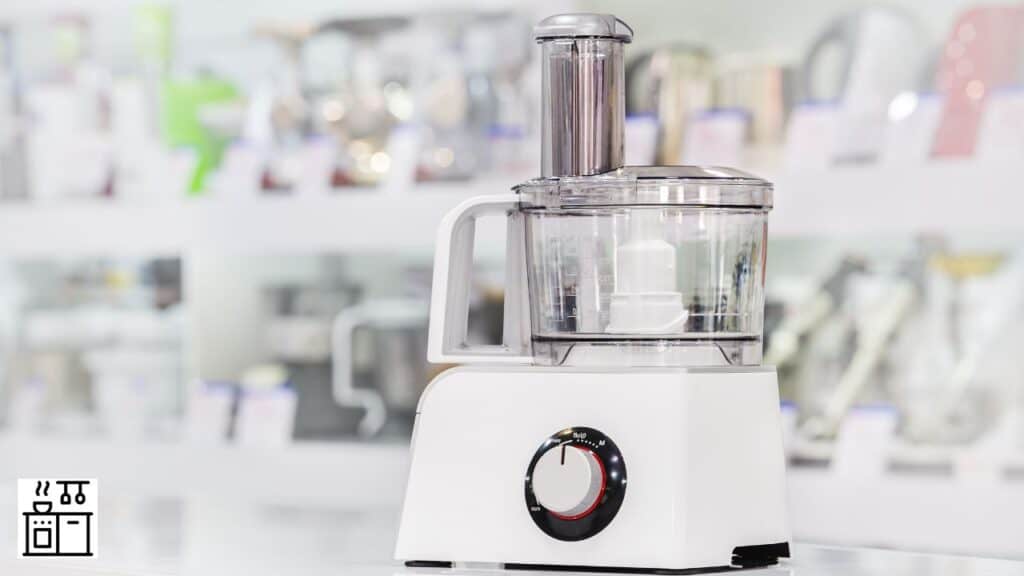When you turn on the food processor, the motor located in the base of the food processor starts, causing the drive adaptor to spin rapidly. This adaptor, positioned at the bottom of the work bowl, links the motor to the blades or discs in the work bowl. The spinning blades or discs then process the ingredients added to the work bowl.
Depending on the food you’re preparing, you’ll use a specific blade or disc. For example, a chopping blade is used for vegetables, while a shredding disc is used for cheese.
Let’s now understand how a food processor works in more detail.
What Are the Main Components of A Food Processor?
Here are the main components of a food processor that you’ll typically find in a standard food processor.
The Base
The base of a food processor houses the motor and supports the work bowl and other parts. It’s the key component that enables the food processor to function effectively.
When you turn on your food processor, the motor in the base activates, powering the blades or discs in the work bowl. This allows your food to be chopped, sliced, or shredded efficiently.
The base also ensures stability, keeping the food processor in place during operation. Without a stable base, food processing would be difficult.
The Work Bowl
The work bowl is where ingredients are mixed, chopped, or sliced. It’s typically constructed from durable plastic or glass to handle food processing tasks.
It fits securely onto the base of your food processor to ensure that food remains in the bowl.
As the blades in the work bowl rotate, they mix, chop, or slice the food to the desired texture.
The Drive Adaptor
The drive adaptor of a food processor connects the motor to the blades and discs. It basically transfers the power from the motor to the blades for chopping and slicing.
Here’s how the drive adaptor works:
- When you turn on your food processor, the motor starts and creates power.
- This power is then passed to the drive adaptor.
- The adaptor sends this power to the blades and discs, making them spin quickly.
Without the drive adaptor, your food processor wouldn’t work effectively.
The Blades and Discs
The blades and discs in your appliance have specific functions.
The S-shaped blade is used for chopping since it can process tough ingredients evenly.
The dough blade is used for kneading. It’s ideal for making bread or pastries.
For slicing and shredding, the slicer/shredder disc is the right choice. It’s capable of precise cuts for tasks like slicing cucumbers or shredding cheese.
The Work Bowl Lid
The work bowl lid of a food processor comes with a feed tube and pusher. It’s useful for adding ingredients during operation.
Here are three key points to remember:
- Secure the lid before operating the processor. It serves as a safety feature.
- The feed tube and pusher will help you to add ingredients into the work bowl without stopping the food processor.
- Without the lid, food processing could be messy and unsafe.
How Do You Assemble and Operate a Food Processor?
Given below are the steps to assemble and operate a food processor.
1. Set up The Food Processor Base
Here are the steps to set up the food processor base:
- Choose a flat, stable surface in your kitchen.
- Place the motorized base of the food processor on the chosen surface. It should be level and not wobble or tilt because this can disrupt operation and safety.
- Understand the controls on the base. Learn the different settings and functions for efficient use of your food processor.
2. Attach the Work Bowl
Next, securely attach the work bowl to the base. It’s vital for the proper functioning of the food processor.
Match the guides or notches on the work bowl with the corresponding parts on the base. Once aligned, twist the bowl until it locks into place.
Ensure that the bowl is firmly secured to prevent it from wobbling or detaching during operation. This step isn’t only important for the operation of the food processor, but also for safety.
3. Insert the Drive Adaptor
The drive adaptor connects the motor to the blade.
Here’s the process for installing it:
- Make sure the work bowl is correctly attached and locked. This gives a solid base for the drive adaptor.
- Align the drive adaptor with the motor shaft. It should fit tightly, without any wobble or looseness.
- Push the drive adaptor onto the shaft until it’s fully seated. It’s properly placed when it doesn’t move or lift off.
4. Choose and Attach the Blade or Disc

Now, attach the blade or disc to the drive adaptor. Make sure that the blade or disc is securely attached to the drive adaptor.
Your recipe dictates what blade or disc you should use. Different blades or discs are used for chopping, slicing, or grating.
Here’s a brief guide:
| Task | Blade/Disc |
|---|---|
| Chopping | S-shaped Blade |
| Slicing | Slicing Disc |
| Grating | Grating Disc |
| Kneading | Dough Blade |
| Whipping | Whisk |
5. Add Ingredients to The Work Bowl
Once your blade or disc is set, begin adding your ingredients to the work bowl. Avoid overfilling since it can hinder your food processor’s performance.
Follow these steps:
- Determine the ingredients required for your recipe.
- Add them one by one to the work bowl, ensuring that they’re spread evenly.
- Stop filling when the bowl is two-thirds full to allow the processor to work efficiently.
6. Start the Food Processor
Once you’ve secured the lid and connected the food processor to a power source, you can start using your food processor.
Take a look at the control panel. It contains various speed settings or functions. These will let you decide how finely or roughly your ingredients should be processed.
For precise chopping, use the pulse function. This feature gives you more control over the chopping process and prevents over-processing of ingredients.
What Are Some Tips and Tricks for Using a Food Processor Effectively?
Once you know how to assemble and use your food processor, here are some tips for its effective use.
Select the Right Blade or Disc for The Task
Choosing the appropriate blade or disc for your task is essential for achieving the desired outcome with your food processor.
Each blade or disc performs a specific function.
- The S-shaped blade: This is a versatile blade ideal for chopping, mixing, and pureeing most ingredients.
- The Dough blade: This blade is particularly useful for those who bake as it’s designed to knead dough for bread or pizza.
- The Disc blade: This blade is best for grating and slicing. It’s the solution for tasks like preparing coleslaw or grating cheese.
Adjust the Speed Settings
Adjusting the speed settings on your food processor can significantly improve the texture or consistency of your meals.
Here’s a straightforward guide:
| Speed Setting | Ideal for | Outcome |
|---|---|---|
| Low | Dough kneading | Smooth, stretchy dough |
| Medium | Cheese grating | Uniform shreds |
| High | Soup pureeing | Silky, smooth soup |
Use the Pulse Function for Precise Chopping
For accurate chopping of ingredients like onions and nuts, use the pulse function of your food processor.
This feature allows you to manage the chopping process and avoid over-chopping the ingredients.
Here’s the procedure:
- Press the pulse button to start chopping in your food processor.
- Release the button to stop chopping. This gives you complete control over the fineness of your chopped ingredients.
- Repeat until you achieve the desired texture.
The pulse function isn’t limited to onions and nuts. It’s also great for creating chunky salsas or roughly chopped vegetables for salads.
Feel free to experiment with it for precise cooking.
Properly Load the Work Bowl
First, place the blade in the work bowl and then add your ingredients into the bowl.
Avoid overfilling the food processor work bowl to ensure optimal performance.
Correct loading of the work bowl maximizes your food processor’s efficiency.
Clean and Maintain the Food Processor Parts
You should clean and maintain your food processor parts regularly to ensure that it functions effectively and lasts longer.
Here’s a 3-step process to clean your food processor parts:
- Remove the Parts: Take off the blades, discs, and bowl to avoid possible cuts while washing them.
- Wash Each Part: Clean each part with warm soapy water. Don’t use harsh cleaners or scrubbers as they could harm the parts.
- Dry and Keep: Dry the parts with a clean towel and keep them in a dry area. This prevents rust and keeps your food processor parts in good condition.
Let Hot Liquids Cool Down
Hot items can produce steam pressure in the food processor. This can possibly cause the lid to burst off and result in a hot spray.
To avoid this, wait until your ingredients are at room temperature before processing.
This step is also important for the quality of your dish. Blending hot items can result in over-processing, changing your food’s texture.
Partially Freeze Meats and Cheeses
For ground meat and shredded cheese, partially freeze them before processing. This improves the texture of your dishes.
Here’s the method:
- Chop the meat or cheese into sizes that can fit into your food processor.
- Freeze them until they’re slightly stiff, not fully frozen.
- Process them in the food processor after taking them out of the freezer.
This technique results in finer and more consistent outcomes, and it also prevents your food processor from overheating.

